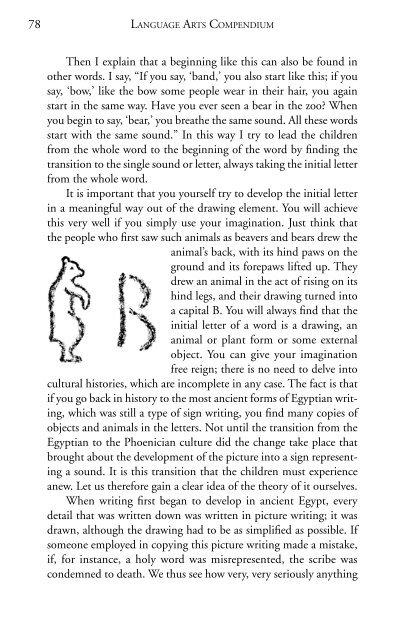Teaching Language arTs in The WaLdorf schooL
Teaching Language arTs in The WaLdorf schooL
Teaching Language arTs in The WaLdorf schooL
You also want an ePaper? Increase the reach of your titles
YUMPU automatically turns print PDFs into web optimized ePapers that Google loves.
78<br />
<strong>Language</strong> Arts Compendium<br />
<strong>The</strong>n I expla<strong>in</strong> that a beg<strong>in</strong>n<strong>in</strong>g like this can also be found <strong>in</strong><br />
other words. I say, “If you say, ‘band,’ you also start like this; if you<br />
say, ‘bow,’ like the bow some people wear <strong>in</strong> their hair, you aga<strong>in</strong><br />
start <strong>in</strong> the same way. Have you ever seen a bear <strong>in</strong> the zoo? When<br />
you beg<strong>in</strong> to say, ‘bear,’ you breathe the same sound. All these words<br />
start with the same sound.” In this way I try to lead the children<br />
from the whole word to the beg<strong>in</strong>n<strong>in</strong>g of the word by f<strong>in</strong>d<strong>in</strong>g the<br />
transition to the s<strong>in</strong>gle sound or letter, always tak<strong>in</strong>g the <strong>in</strong>itial letter<br />
from the whole word.<br />
It is important that you yourself try to develop the <strong>in</strong>itial letter<br />
<strong>in</strong> a mean<strong>in</strong>gful way out of the draw<strong>in</strong>g element. You will achieve<br />
this very well if you simply use your imag<strong>in</strong>ation. Just th<strong>in</strong>k that<br />
the people who first saw such animals as beavers and bears drew the<br />
animal’s back, with its h<strong>in</strong>d paws on the<br />
ground and its forepaws lifted up. <strong>The</strong>y<br />
drew an animal <strong>in</strong> the act of ris<strong>in</strong>g on its<br />
h<strong>in</strong>d legs, and their draw<strong>in</strong>g turned <strong>in</strong>to<br />
a capital B. You will always f<strong>in</strong>d that the<br />
<strong>in</strong>itial letter of a word is a draw<strong>in</strong>g, an<br />
animal or plant form or some external<br />
object. You can give your imag<strong>in</strong>ation<br />
free reign; there is no need to delve <strong>in</strong>to<br />
cultural histories, which are <strong>in</strong>complete <strong>in</strong> any case. <strong>The</strong> fact is that<br />
if you go back <strong>in</strong> history to the most ancient forms of Egyptian writ<strong>in</strong>g,<br />
which was still a type of sign writ<strong>in</strong>g, you f<strong>in</strong>d many copies of<br />
objects and animals <strong>in</strong> the letters. Not until the transition from the<br />
Egyptian to the Phoenician culture did the change take place that<br />
brought about the development of the picture <strong>in</strong>to a sign represent<strong>in</strong>g<br />
a sound. It is this transition that the children must experience<br />
anew. Let us therefore ga<strong>in</strong> a clear idea of the theory of it ourselves.<br />
When writ<strong>in</strong>g first began to develop <strong>in</strong> ancient Egypt, every<br />
detail that was written down was written <strong>in</strong> picture writ<strong>in</strong>g; it was<br />
drawn, although the draw<strong>in</strong>g had to be as simplified as possible. If<br />
someone employed <strong>in</strong> copy<strong>in</strong>g this picture writ<strong>in</strong>g made a mistake,<br />
if, for <strong>in</strong>stance, a holy word was misrepresented, the scribe was<br />
condemned to death. We thus see how very, very seriously anyth<strong>in</strong>g

















